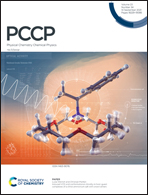Effective π-electron number and symmetry perturbation effect on the two-photon absorption of oligofluorenes†
Abstract
Fluorene-based molecules exhibit significant nonlinear optical responses and multiphoton absorption in the visible region, which, combined with the high fluorescence quantum yield in organic solvents, could make this class of materials potentially engaging in diverse photonics applications. Thus, herein, we have determined the two-photon absorption (2PA) of oligofluorenes containing three, five, and seven repetitive units by employing the wavelength-tunable femtosecond Z-scan technique. Our outcomes have shown that the 2PA cross-section in oligofluorenes presents an enhanced value of around 18 GM per Neff, in which Neff is the effective number of π-electrons, for the pure 2PA allowed transition (11Ag-like → 21Ag-like). Furthermore, a weak 2PA transition was observed in the same spectral region strongly allowed by one-photon absorption (11Ag-like → 11Bu-like). This last result suggests a molecular symmetry perturbation, probably induced by the molecular disorder triggered by the increase of moieties in the oligofluorene structure. We have calculated the permanent dipole moment difference related to the lowest-energy transition using the Lippert-Matagaformalism and the 2PA sum-over-states approach to confirm this assumption. Moreover, we have estimated the fundamental limits for the 2PA cross-section in oligofluorenes.



 Please wait while we load your content...
Please wait while we load your content...